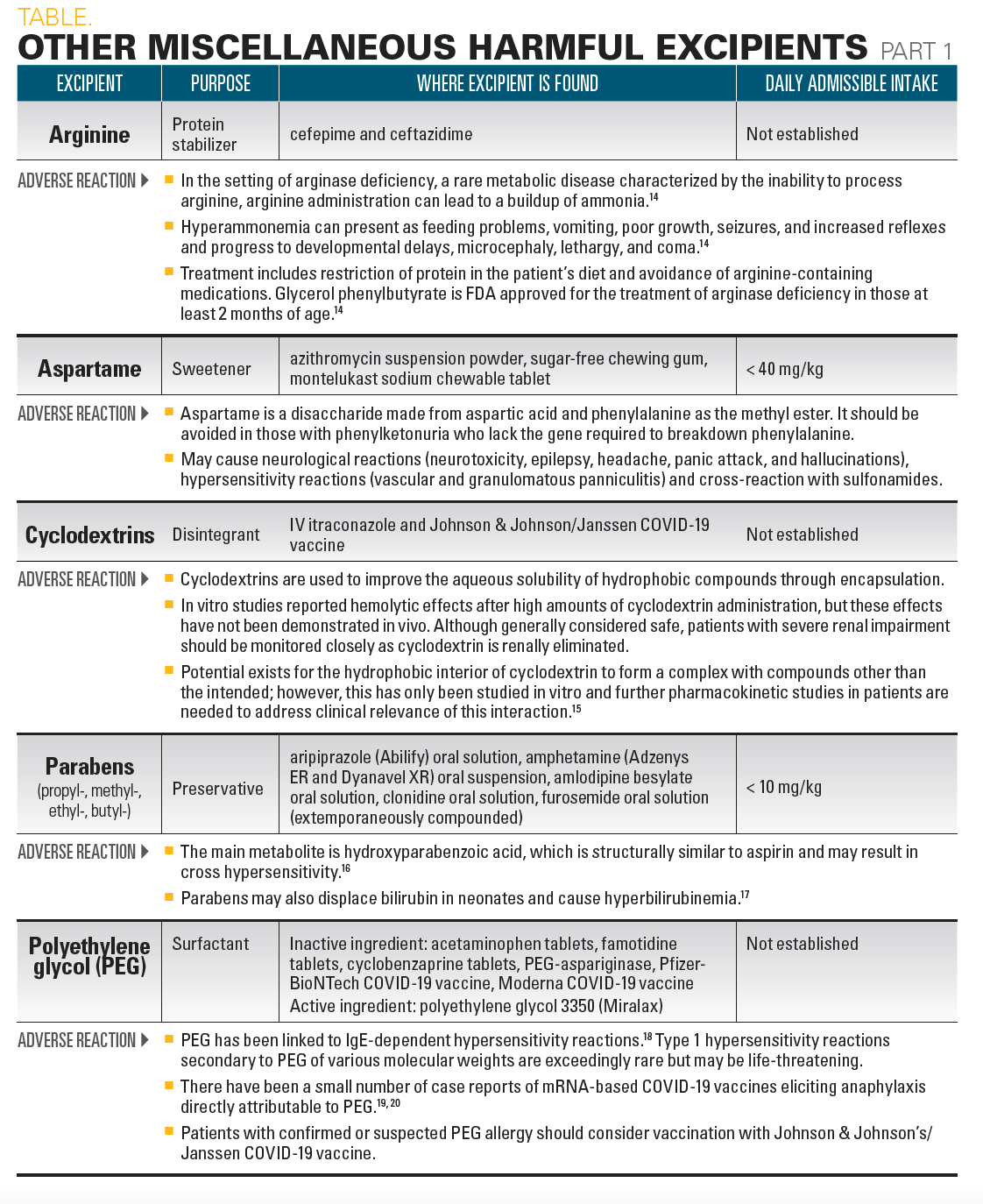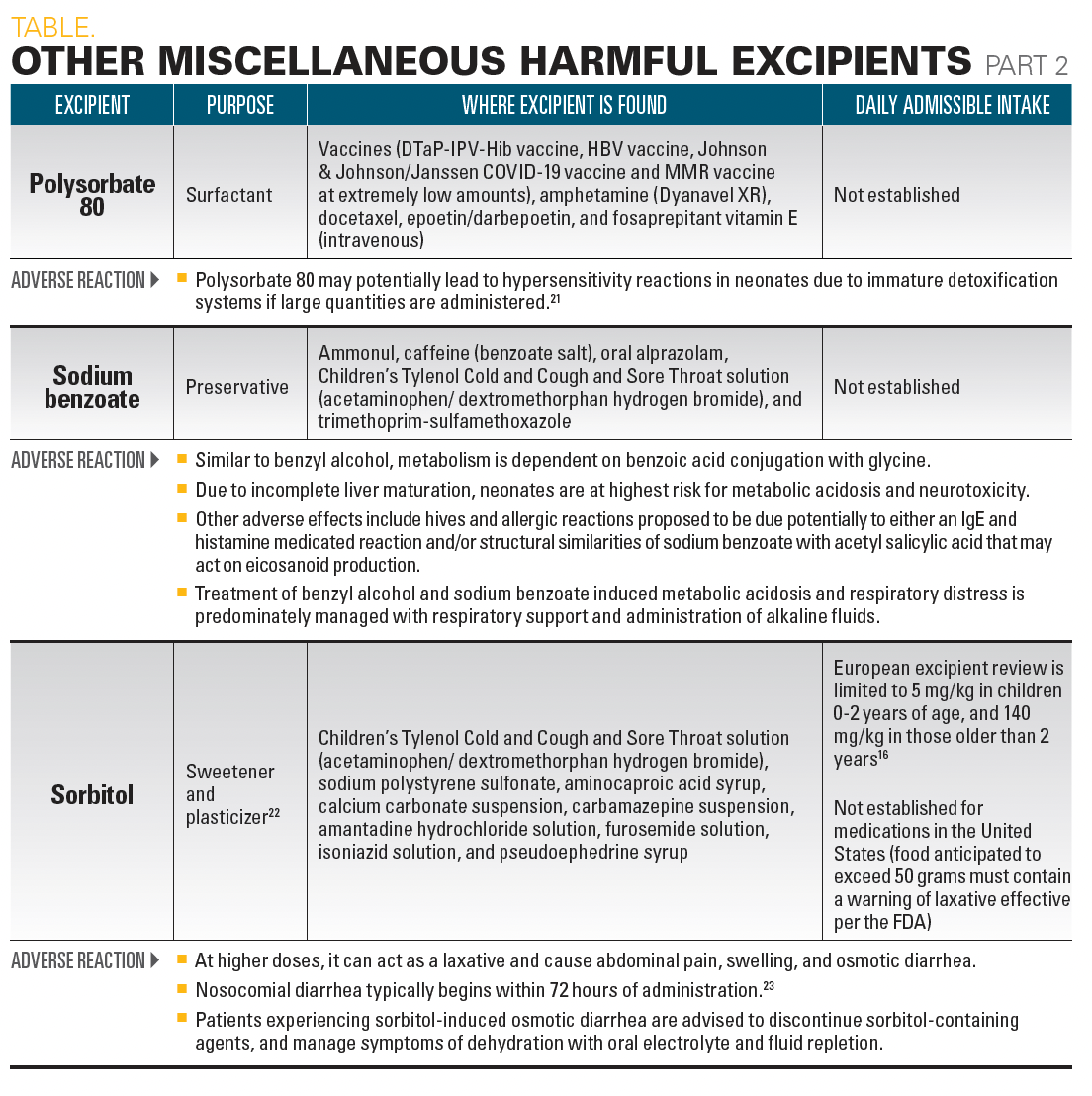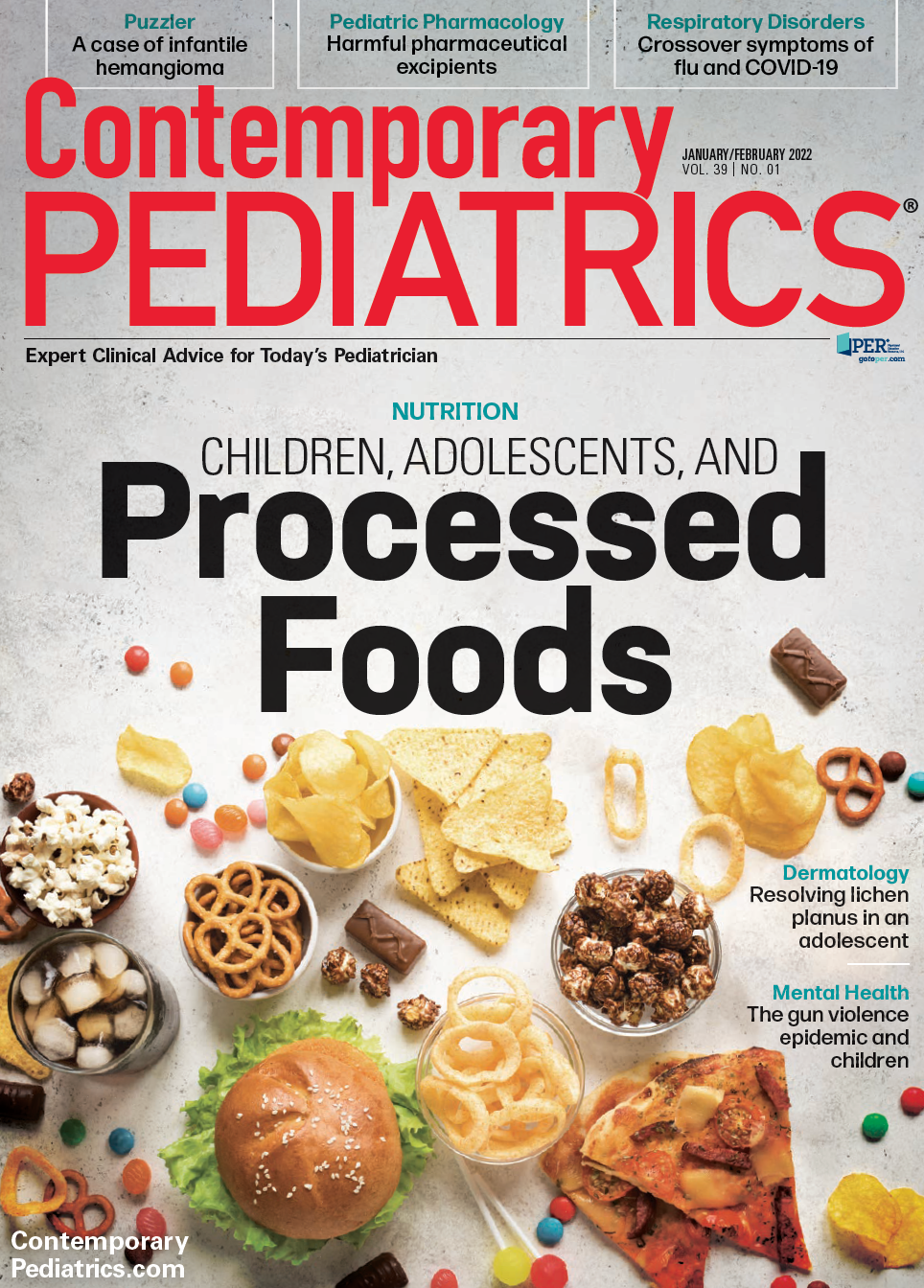Harmful excipients for pediatric patients
Evidence suggests some pharmaceutical excipients in medications may have adverse effects on pediatric patients. Here’s what you should know.
The United States Pharmacopeia (USP) defines pharmaceutical excipients as substances other than the active pharmaceutical ingredient that is intentionally included in an approved drug delivery system or finished drug product.1 There is a growing body of literature to suggest pharmaceutical excipients contained in commercially available and extemporaneously compounded medications may have adverse clinical effects on pediatric and adult patients. The US Food and Drug Administration (FDA) requires over-the-counter (OTC) products marketed under their respective drug monographs to contain only suitable inactive ingredients which are administered in safe amounts; however, it is entirely under the responsibility of the manufacturer to comply with these standards.2 Due to the vast differences in metabolism and clearance of medications in various stages of development, it is difficult to assess precise harmful levels of pharmaceutical excipients and the extent to which they will impact patients. Pediatric pharmacokinetic and pharmacodynamic profiles can vary drastically, and with this variability ultimately comes variance in safety profiles. Many of these discoveries have been attributed to therapeutic misadventures, such as the discovery of the neonatal gasping syndrome when physicians started to use bacterial static saline flushes containing benzyl alcohol.3 In a 2019 study surveying 42,052 oral solid dosage forms from the Pillbox database, an American database regulated by the National Institutes of Health, medications were found on average to contain 8.8 inactive ingredients.4 Given the overall prevalence of potentially harmful pharmaceutical excipients in various medications, the potential risks posed to children remains a pertinent topic for discussion.
Ethanol
Ethanol is the second most commonly used solvent in oral liquid medications, preceded by water. Ethanol additionally has antimicrobial properties. Patients with impaired alcohol dehydrogenase enzyme systems, including children aged less than 6 years, patients with hepatic disease, and patients treated with disulfiram or metronidazole are at greatest risk of toxicity, as alcohol dehydrogenase activity is less than 20% of adult enzymatic activity in children under the age of 6 years. Prenatal exposure to ethanol may result in fetal alcohol syndrome. The FDA, American Academy of Pediatrics (AAP), and European Medicines Agency (EMA) have all published dose limits related to ethanol-containing medications; however, these standards are based on acute central nervous system (CNS) toxicity after single-dose administration.5-7 Although most are familiar with the signs and symptoms of ethanol intoxication and acute poisonings in adults, children may present with hypoglycemia, hypothermia, acidosis, tachycardia, seizures, and disorders of consciousness. These effects should be treated promptly with supportive care measures and the drug should be discontinued if possible. Very little is understood about the longterm effects of ethanol exposure in children; however, the clinical benefits of administering ethanol-containing medications may outweigh the potential risks. For this reason, administration of extemporaneously compounded buprenorphine sublingual drops (30% ethanol), phenobarbital elixir and oral solution (15% ethanol), and methadone oral solution (9.8% ethanol) in neonatal abstinence syndrome has remained controversial. Additional examples of medications containing ethanol include dexamethasone oral solution (30% ethanol), furosemide oral solution (11.5% ethanol), digoxin oral solution (10% ethanol), and many others. Alternative formulations or medications should be considered if possible, especially when the product contains more than 5% ethanol by volume.
Propylene glycol
Propylene glycol is a solvent used in many oral, topical, and intravenous medications and as a humectant in some topical medications. It is metabolized to lactaldehyde by alcohol dehydrogenase. Lactaldehyde is converted by aldehyde dehydrogenase to lactate, and accumulation may lead to an anion gap metabolic acidosis. Propylene glycol may additionally result in direct organ toxicity through an unknown mechanism, manifesting as CNS depression and seizures, cardiac arrhythmias, hypotension, respiratory depression, hemolysis, and acute kidney injury. Patients with impaired alcohol dehydrogenase systems, as discussed in the ethanol section above, and renal impairment are at greatest risk. This becomes most clinically relevant in patients receiving continuous infusions of medications containing propylene glycol as an excipient. Examples include esmolol (25% propylene glycol), lorazepam (80% propylene glycol), and phenobarbital (40% to 70% propylene glycol). Manifestations of toxicity should be treated promptly and the drug should be discontinued if possible. Propylene glycol can be removed by hemodialysis. Topical administration may result in contact dermatitis. Systemic toxicity has been reported rarely in patients with a damaged stratum corneum (eg, severe diaper rash, burns, toxic epidermolysis), including patients receiving silver sulfadiazine cream for burns. However, propylene glycol is highly water soluble and therefore not expected to be absorbed through the dermis in any appreciable amount. Routine, intermittent administration of oral, topical, and intravenous medications containing propylene glycol is generally considered safe. Clinicians should use caution and monitor lactate, comprehensive or basic metabolic panel, anion gap, serum osmolarity, pH, and neurologic, cardiovascular, and respiratory status in patients at risk for accumulation and systemic toxicity, particularly those on continuous infusions.
Table, part 1

Benzalkonium chloride
Benzalkonium chlorides (BAC) are cationic surfactants commonly used for their broad-spectrum antimicrobial properties in topical sanitizers, nasal sprays, ophthalmic solutions, and nebulized solutions.3 The mechanism of toxicity is not abundantly clear, but may be related to oxidative stress.8 BAC is generally considered safe and can be found in OTC nasal decongestant sprays, including sodium chloride and oxymetazoline. Nasal sprays containing less than 0.1% BAC have been found to be safe. Some data suggest it may damage the human nasal epithelia and/or cause exacerbation of rhinitis medicamentosa at higher concentrations. When used in ophthalmic preparations such as prednisolone acetate ophthalmic suspension (0.01% BAC), various OTC eye lubricants, and others, BAC may cause dry eye, trabecular meshwork degeneration, ocular inflammation, and mitotoxic effects.9 Adverse effects have been demonstrated in concentrations as low as 0.0001%. Recommending short courses of BAC-containing nasal sprays or ophthalmic products is the ideal way to avoid these adverse effects. Examples of inhaled medications containing BAC include nonsterile, multidose 0.5% albuterol solutions; nonsterile, screw-cap, unit-dose 0.083% albuterol nebulizer solutions; and nonsterile, multidose metaproterenol solutions. Use of BAC-containing products has resulted in poor pulmonary outcomes including decline in forced expiratory volume 1 by 20% or more, increased risk of requiring additional respiratory support, and lower likelihood of stopping continuous albuterol in patients with asthma when compared to preparations without BAC.10,11 Albuterol preparations without BAC should be used preferentially as they are now available as 5-mg/mL multidose concentrate for continuous nebulization and 2.5 mg/3 mL-unit dose bullets.
Benzyl alcohol
Benzyl alcohol is a preservative used in medications for its antibacterial properties. Due to incomplete liver maturation, benzoic acid may not be converted to the renally excreted metabolite hippuric acid in infants and children. Large administrations in neonates may lead to elevated benzoic acid concentrations, metabolic acidosis, respiratory depression, and gasping syndrome. Gasping syndrome occurs when metabolic acidosis and respiratory depression progress to gasping respirations, renal failure, CNS depression, seizures, and hypotension. Due to these concerns and documented evidence of increased mortality in infants weighing less than 1250 g receiving intravascular catheter washes containing benzyl alcohol, benzyl alcohol is contraindicated in patients less than 3 years of age.12 The EMA has suggested doses greater than 100 to 200 mg/kg/24h are linked to neonatal gasping syndrome.13 A report published by the Centers for Disease Control and Prevention suggested a similar range of 99 to 405 mg/kg/24h may be linked to accumulation of benzyl alcohol in neonates. The FDA recommends the exclusion of benzyl alcohol from medications, intravenous fluids, and heparin washing solutions for newborns. Although benzyl alcohol is commonly found in oral formulations of cetirizine chewable tablets, diphenhydramine tablets, hydroxyurea tablets, montelukast chewable tablets, and olanzapine oral disintegrating tablets, these medications are typically used in older children with the developed metabolic capacity to process benzyl alcohol exposure and are therefore at less risk for toxicity. Benzyl alcohol has been found in some parenteral formulations of aminophylline, amiodarone, bumetanide, diazepam, furosemide, heparin, metoclopramide, midazolam, lorazepam, parenteral vitamin E, multidose vial pediatric trace elements (neonatal single-dose vials should be reserved for neonates), parenteral vitamin K, multivitamin infusion, and trimethoprim-sulfamethoxazole.13 Treatment of complications due to benzyl alcohol are predominately symptom focused (ie, reversal of metabolic acidosis with sodium bicarbonate, management of respiratory depression with increased respiratory support).
Table, part 2

Conclusion
Ultimately, there is a paucity of safety data for several of the pharmaceutical excipients discussed. There is a great need for further investigation to evaluate the safety of pharmaceutical excipients. There is also a need for more transparency and improved labeling regarding excipient content of various medications. Clinicians should be mindful of pharmaceutical excipients in medications and monitor for signs and symptoms of toxicity.
Commentary
Adverse effects of active medicines and pharmaceutical excipients can be characterized as a dose-dependent, immune-mediated (eg, anaphylaxis), or iatrogenic event. The ontogeny of pediatric organ systems has a direct influence on dose-dependent adverse events. Individuals with a history of polyethylene glycol hypersensitivity/anaphylaxis should avoid receiving mRNA COVID-19 vaccines and the commonly used laxative, polyethylene glycol electrolyte solution (eg, Miralax), due to its presence as an excipient and active medicine, respectively. - Carlton K.K. Lee, Pharm.D., MPH, FASHP, FPPAG, BCPPS, Pediatric Pharmacy Residency Program director, Johns Hopkins Children’s Center, Baltimore, Maryland
References
- U. S. Pharmacopeia. Sheehan C. Novel excipients: updates on recent survey findings. November 13, 2019. Accessed November 14, 2021. https://www.usp.org/sites/default/files/usp/document/stakeholder-forum/2019-11-13-06-novel-excipients-update-on-recent-survey-findings-catherine-sheehan.pdf
- United States Food and Drug Administration. Guidance for industry. Nonclinical studies for the safety evaluation of pharmaceutical excipients. Published May 2005. Accessed November 14, 2021. https://www.fda.gov/media/72260/download
- Pereira BMP, Tagkopoulos I. Benzalkonium chlorides: uses, regulatory status, and microbial resistance. Appl Environ Microbiol. 2019;85(13):e00377-19. doi:10.1128/aem.00377-19
- Reker D, Blum SM, Steiger C, et al. "Inactive" ingredients in oral medications. Sci Transl Med. 2019;11(483):eaau6753. doi:10.1126/scitranslmed.aau6753
- United States Food and Drug Administration. Over-the-counter drug products intended for oral ingestion that contain alcohol. Final Rule. 21 Code of Federal Regulations (CFR) Part 328. 2020. Amended November 23, 2021. Accessed November 30, 2021. https://www.ecfr.gov/current/title-21/chapter-I/subchapter-D/part-328
- European Medicines Agency. Committee for Medicinal Products for Human Use (CHMP). Information for the package leaflet regarding ethanol used as an excipient in medicinal products for human use. Updated September 28, 2018. Accessed November 30, 2021. https://www.ema.europa.eu/en/documents/scientific-guideline/information-package-leaflet-regarding-ethanol-used-excipient-medicinal-products-human-use_en.pdf
- Meyers, RS, Thackray, J, Matson, KL, et al. Key potentially inappropriate drugs in pediatrics: The KIDs List. J Pediatr Pharmacol Ther. 2020;25(3):175-191. doi:10.5863/1551-6776-25.3.175
- Kwon D, Lim Y, Kwon J, et al. Evaluation of pulmonary toxicity of benzalkonium chloride and triethylene glycol mixtures using in vitro and in vivo systems. Environ Toxicol. 2019;34(5):561-572. doi:10.1002/tox.22722
- Datta S, Baudouin C, and Brignole-Baudouin F, Denoyer A, Cortopassi GA. The eye drop preservative benzalkonium chloride potently induces mitochondrial dysfunction and preferentially affects LHON mutant cells. Invest Ophthalmol Vis Sci. 2017;58(4):2406-2412. doi:10.1167/iovs.16-20903
- Prabhakaran S, Abu-Hasan M, Hendeles L. Benzalkonium chloride: a bronchoconstricting preservative in continuous albuterol nebulizer solutions. Pharmacotherapy. 2017;37(5):607-610. doi:10.1002/phar.1929
- Pertzborn M, Prabhakaran S, Abu-Hasan M, et al. Continuous albuterol with benzalkonium in children hospitalized with severe asthma. Pediatrics. 2020;145(4):e20190107. doi:10.1542/peds.2019-0107
- Valeur KS, Holst H, Allegaert K. Excipients in neonatal medicinal products: never prescribed, commonly administered. Pharmaceut Med. 2018; 32(4):251-258. doi:10.1007/s40290-018-0243-9
- European Medicines Agency- Science Medicines Health. Committee for Human Medicinal Products Questions and answers on benzyl alcohol used as an excipient in medicinal products for human use (2017). Accessed November 4, 2021. https://www.ema.europa.eu/en/documents/scientific-guideline
- National Institutes of Health. Arginase deficiency. Genetic and Rare Diseases Information Center. Accessed November 12, 2021. https://rarediseases.info.nih.gov/diseases/5840/arginase-deficiency
- Durk MR, Jones NS, Liu J, et al. Understanding the effect of hydroxypropyl‐β‐cyclodextrin on fenebrutinib absorption in an itraconazole-fenebrutinib drug-drug interaction study. Clin Pharmacol Ther. 2020;108(6):1224-1232. doi:10.1002/cpt.1943
- Rouaz K, Chiclana-Rodríguez B, Nardi-Ricart A, et al. Excipients in the paediatric population: a review. Pharmaceutics. 2021;13(3):387. doi:10.3390/pharmaceutics13030387
- Johnson K, Maple B, Brion L. Neonatal jaundice. In: McInerny TK, Adam HM, Campbell DE, DeWitt TG, Foy JM, Karnat DM, eds. American Academy of Pediatrics Textbook of Pediatric Care. American Academy of Pediatrics; 2017.
- Sellaturay P, Nasser S, Ewan P. Polyethylene glycol-induced systemic allergic reactions (anaphylaxis). J Allergy Clin Immunol Pract. 2021;9(2):670-675. doi:10.1016/j.jaip.2020.09.029
- Sellaturay P, Nasser S, Islam S, et al. Polyethylene glycol (PEG) is a cause of anaphylaxis to the Pfizer/BioNTech mRNA COVID-19 vaccine. Clin Exp Allergy. 2021;5(6)1:861-863. doi:10.1111/cea.13874
- McSweeney M, Mohan M, Commins S, Lai SK. Anaphylaxis to Pfizer/BioNTech mRNA COVID-19 vaccine in a patient with clinically confirmed PEG allergy. Front Allergy. 2021. https://www.frontiersin.org/articles/10.3389/falgy.2021.715844/full doi:10.3389/falgy.2021.715844
- Kriegel C, Festag M, Kishore RSK, Roethlisberger D, Schmitt G. Pediatric safety of polysorbates in drug formulations. Children (Basel). 2019;7(1):1. doi:10.3390/children7010001
- Peiré G. Pediatric pharmacology. Anales Ranm. 2019;136(02):218-221. doi:10.32440/ar.2019.136.02.rev17
- Bayraktar Ekincioglu A, Demirkan K. Awareness of healthcare professionals about sorbitol-related diarrhea in pediatrics. Journal of Medical and Surgical Intensive Care Medicine. 2017;8(1):14-18. doi:10.5152/dcbybd.2017.1454
Newsletter
Access practical, evidence-based guidance to support better care for our youngest patients. Join our email list for the latest clinical updates.
